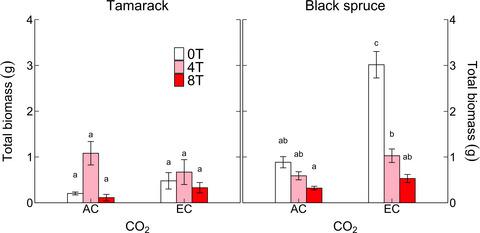当前位置:
X-MOL 学术
›
Glob. Change Biol.
›
论文详情
Our official English website, www.x-mol.net, welcomes your
feedback! (Note: you will need to create a separate account there.)
Contrasting acclimation responses to elevated CO2 and warming between an evergreen and a deciduous boreal conifer.
Global Change Biology ( IF 10.8 ) Pub Date : 2020-04-17 , DOI: 10.1111/gcb.15084 Mirindi E Dusenge 1, 2 , Sasha Madhavji 1 , Danielle A Way 1, 3, 4
Global Change Biology ( IF 10.8 ) Pub Date : 2020-04-17 , DOI: 10.1111/gcb.15084 Mirindi E Dusenge 1, 2 , Sasha Madhavji 1 , Danielle A Way 1, 3, 4
Affiliation

|
Rising atmospheric carbon dioxide (CO2 ) concentrations may warm northern latitudes up to 8°C by the end of the century. Boreal forests play a large role in the global carbon cycle, and the responses of northern trees to climate change will thus impact the trajectory of future CO2 increases. We grew two North American boreal tree species at a range of future climate conditions to assess how growth and carbon fluxes were altered by high CO2 and warming. Black spruce (Picea mariana, an evergreen conifer) and tamarack (Larix laricina, a deciduous conifer) were grown under ambient (407 ppm) or elevated CO2 (750 ppm) and either ambient temperatures, a 4°C warming, or an 8°C warming. In both species, the thermal optimum of net photosynthesis (ToptA ) increased and maximum photosynthetic rates declined in warm-grown seedlings, but the strength of these changes varied between species. Photosynthetic capacity (maximum rates of Rubisco carboxylation, Vcmax , and of electron transport, Jmax ) was reduced in warm-grown seedlings, correlating with reductions in leaf N and chlorophyll concentrations. Warming increased the activation energy for Vcmax and Jmax (EaV and EaJ , respectively) and the thermal optimum for Jmax . In both species, the ToptA was positively correlated with both EaV and EaJ , but negatively correlated with the ratio of Jmax /Vcmax . Respiration acclimated to elevated temperatures, but there were no treatment effects on the Q10 of respiration (the increase in respiration for a 10°C increase in leaf temperature). A warming of 4°C increased biomass in tamarack, while warming reduced biomass in spruce. We show that climate change is likely to negatively affect photosynthesis and growth in black spruce more than in tamarack, and that parameters used to model photosynthesis in dynamic global vegetation models (EaV and EaJ ) show no response to elevated CO2 .
中文翻译:

常绿和落叶北方针叶树之间对二氧化碳升高和变暖的不同适应反应。
到本世纪末,大气中二氧化碳(CO2)浓度的上升可能会使北部纬度升高至8°C。北方森林在全球碳循环中扮演着重要角色,因此北方树木对气候变化的反应将影响未来CO2增长的轨迹。我们在未来的气候条件范围内种植了两种北美寒带树种,以评估高二氧化碳和变暖如何改变生长和碳通量。黑云杉(Picea mariana,常绿针叶树)和塔玛拉克(Larix laricina,落叶针叶树)在环境温度(407 ppm)或升高的二氧化碳(750 ppm)和环境温度,4°C升温或8°C的条件下生长C变暖。在这两个物种中,温暖生长的幼苗的净光合作用(ToptA)的热最适值增加,最大光合速率下降,但是这些变化的强度因物种而异。温育幼苗的光合作用能力(Rubisco羧化反应的最大速率Vcmax和电子传递的最大速率Jmax)降低,这与叶片氮和叶绿素浓度的降低有关。变暖增加了Vcmax和Jmax的活化能(分别为EaV和EaJ)和Jmax的热最优值。在这两个物种中,ToptA与EaV和EaJ均呈正相关,但与Jmax / Vcmax的比呈负相关。呼吸能适应升高的温度,但对呼吸Q10却没有治疗效果(叶片温度每升高10°C,呼吸就会增加)。温度升高4°C时,番茄的生物量增加,而云杉中的生物量减少。
更新日期:2020-03-17
中文翻译:

常绿和落叶北方针叶树之间对二氧化碳升高和变暖的不同适应反应。
到本世纪末,大气中二氧化碳(CO2)浓度的上升可能会使北部纬度升高至8°C。北方森林在全球碳循环中扮演着重要角色,因此北方树木对气候变化的反应将影响未来CO2增长的轨迹。我们在未来的气候条件范围内种植了两种北美寒带树种,以评估高二氧化碳和变暖如何改变生长和碳通量。黑云杉(Picea mariana,常绿针叶树)和塔玛拉克(Larix laricina,落叶针叶树)在环境温度(407 ppm)或升高的二氧化碳(750 ppm)和环境温度,4°C升温或8°C的条件下生长C变暖。在这两个物种中,温暖生长的幼苗的净光合作用(ToptA)的热最适值增加,最大光合速率下降,但是这些变化的强度因物种而异。温育幼苗的光合作用能力(Rubisco羧化反应的最大速率Vcmax和电子传递的最大速率Jmax)降低,这与叶片氮和叶绿素浓度的降低有关。变暖增加了Vcmax和Jmax的活化能(分别为EaV和EaJ)和Jmax的热最优值。在这两个物种中,ToptA与EaV和EaJ均呈正相关,但与Jmax / Vcmax的比呈负相关。呼吸能适应升高的温度,但对呼吸Q10却没有治疗效果(叶片温度每升高10°C,呼吸就会增加)。温度升高4°C时,番茄的生物量增加,而云杉中的生物量减少。











































 京公网安备 11010802027423号
京公网安备 11010802027423号